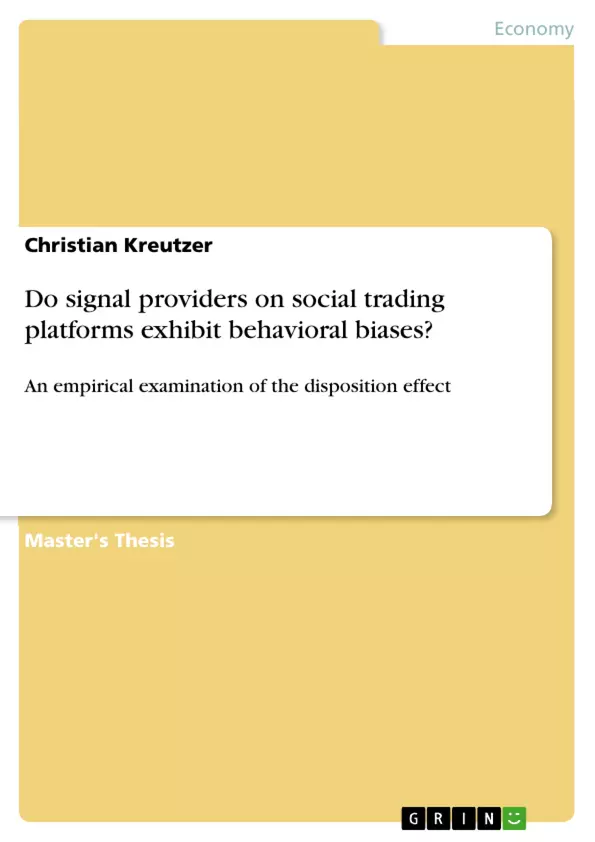This work examines the effect of transparency on the trading behaviour in the context of social trading. The focus lies on the effect of transparency on the behavioural bias known as the disposition effect. The disposition effect indicates that trader tend to hold their losing stocks for a too long amount of time and sell their profitable stocks too soon. Additionally, the effect of transparency on the home bias will be analysed. The home bias is the trader’s preference for domestic stocks at the expense of portfolio diversification.
The underlying question is: "Can transparency mitigate the extent of the disposition effect and home bias?" In the past, there has been a wide extent of competing theories about which factors influence these biases. However, a factor which has not been in the center of attention is transparency; in other words a permanent visible statistic about the trader’s performance, trades, positions and their success. The results of this paper may help to draw comparisons to the field of traditional fund managers.
To begin with, this work will start by providing information about the status quo of the disposition effect and the home bias. This will show why it is important to look at transparency. Next, the idea behind social trading will be explained and the platform Wikifolio will be introduced. The empirical part will be divided into two segments. The first segment will cover the disposition effect. It will start with the underlying hypothesis, followed by the data sampling and empirical results. The segment about the empirical results will contain two panel data regressions that will analyse the trader’s holding time of losing and gaining positions separately. The second segment will cover the hypothesis, data and empirical results of the home bias.
Inhaltsverzeichnis (Table of Contents)
- 1. Introduction
- 2. Literature Review
- 2.1 Review on the Disposition Effect
- 2.1.1 The Four Key Elements of the Disposition Effect
- 2.1.2 Cognitive Dissonance
- 2.1.3 What Factors influence the Disposition Effect?
- 2.2 Review on the Home Bias
- 3. Social Trading
- 4. Methodology and Empirical Results
- 4.1 Disposition Effect
- 4.1.1 Hypotheses
- 4.1.2 Data and Empirical Approach
- 4.1.3 Empirical Results
- 4.1.4 Odean Method
- 4.2 Home Bias
- 4.2.1 Hypothesis
- 4.2.2 Data and Empirical Approach
- 4.2.3 Empirical Results
- 5. Limitations and Further Research
Zielsetzung und Themenschwerpunkte (Objectives and Key Themes)
This paper examines the effect of transparency on the trading behavior in the context of social trading. It focuses on the effect of transparency on the disposition effect and the home bias, two well-known behavioral biases observed in traders. The main objective is to investigate whether transparency can mitigate the extent of these biases. Key themes explored in this thesis include:- The disposition effect and its factors
- The home bias and its influence on portfolio diversification
- The role of transparency in mitigating behavioral biases
- Empirical analysis of social trading platforms
- Comparative analysis of social traders and traditional fund managers
Zusammenfassung der Kapitel (Chapter Summaries)
- Chapter 1: Introduction introduces the topic of transparency and its potential impact on the disposition effect and home bias in the context of social trading. It highlights the research question and outlines the structure of the paper.
- Chapter 2: Literature Review provides a comprehensive overview of the disposition effect and home bias, highlighting relevant theories, research findings, and factors that influence these biases. It also emphasizes the importance of examining transparency in this context.
- Chapter 3: Social Trading discusses the concept of social trading, introducing the platform Wikifolio as a case study. It provides insights into the platform's mechanics and its role in facilitating transparency.
- Chapter 4: Methodology and Empirical Results delves into the empirical analysis of the disposition effect and home bias. It outlines the hypotheses, data sampling, and empirical approach used in the study, presenting the findings of panel data regressions and Odean method analysis.
Schlüsselwörter (Keywords)
This thesis focuses on the impact of transparency on the disposition effect and home bias in the context of social trading. Key terms and concepts include: transparency, behavioral biases, disposition effect, home bias, social trading, Wikifolio, empirical analysis, panel data regressions, Odean method, trader performance, portfolio diversification.- Quote paper
- Christian Kreutzer (Author), 2018, Do signal providers on social trading platforms exhibit behavioral biases?, Munich, GRIN Verlag, https://www.grin.com/document/496076



